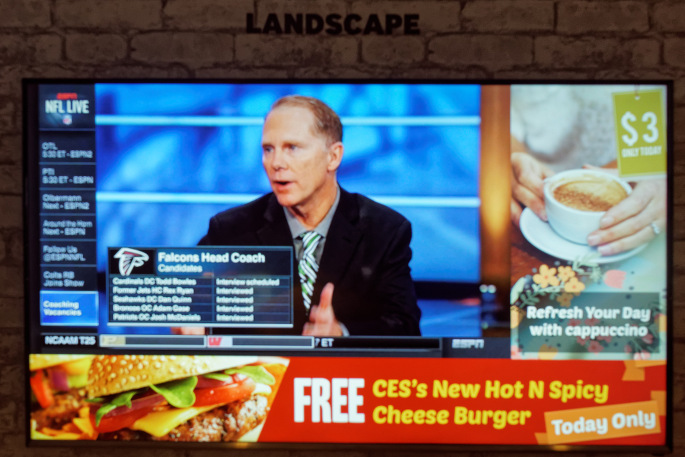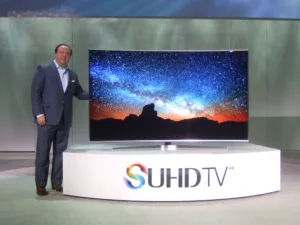Samsung’s CES press conference is always elbow-room only. While we managed to secure a seat (through use of aforementioned elbows), cameramen in the aisles severely hampered the ability to take photos!
Tim Baxter, president and COO of Samsung America, looked back at the company’s achievements over the past year.
In terms of UltraHD, Samsung’s work culminated in an UltraHD market share greater than 60% in the USA. Half of the UltraHD TVs the company sells are now curved, “Proving that consumers see the value in curved TVs”. Samsung also sees a huge opportunity in the wearable and IoT market. 32% of US adults are interested in IoT devices, but only 2% actually own one, according to Samsung’s research.
Baxter also mentioned Samsung’s Milk Music and Milk Video services, which are being expanded to the company’s smart TVs this year. A new service will be launched called Milk VR, specifically for users of the Gear VR headset; it will be a daily stream of 360° videos, produced with partners including Red Bull Media House. Skybound Entertainment, producer of The Walking Dead, will also provide content, said David Alpert of the company.
Joe Stinziano, who rescued last year’s press conference from Michael Bay’s crash-and-burn, appeared to continue the UltraHD discussion. He said that not all UltraHD TVs provide the colour and detail that should be expected, so Samsung has joined the new UHD Alliance, which aims to set UltraHD video standards, promote the format and establish a technology roadmap.
Mike Dunn of 20th Century Fox joined Stinziano to talk about the UHD Alliance. It should be made easy for consumers to know which products provide the best UltraHD experience, he said: those with features such as HDR, a wide colour gamut and immersive audio.
‘S’ Is For…Nanocrystals?7
Speaking of colour gamuts, Samsung has ‘created’ a technology that produces colours “better than OLED”: SUHD, which relies on nanocrystals. However – sorry, Samsung – this is really just quantum dots by a new name. The nanocrystals are applied to the blue LED backlight. Three TV series will be introduced: JD9500 (65″ and 88″, curved), JS9000 and JS8500, with nine models in total.
The ‘S’ doesn’t stand for anything in particular, but has been used for ‘spectacular’, ‘stunning’ and ‘Samsung’, among others! Stinziano said that Samsung’s JS9500 is 2.5 times brighter than an OLED set – up to around 1,000 cd/m². It also has deep blacks and “64 times the colour expression” of a conventional LCD TV.A conceptual SUHD TV, the 82″ S9W, was introduced by Yves Behar, founder of industrial design firm Fuseproject. Behar’s team designed the TV, which is curved and mounted on a pedestal-type stand, with speakers and a sub-woofer hidden inside.
Wonjin Lee, EVP of Samsung, introduced the Tizen OS for smart TVs. Lee expects the term ‘smart TV’ to disappear soon, as the majority of models will have this functionality. All of Samsung’s 2015 smart TVs will be based on Tizen, which actually looks very similar to LG’s WebOS! Tizen TVs can automatically detect previously-paired Bluetooth devices (Quick Connect), and will link with them for content sharing at the press of a button.
Finally in terms of displays, a new tablet will be launched later in the year as part of Samsung’s Chef Collection. A dedicated Chef Collection app will be pre-installed (although other devices will also be able to download it); we assume that the tablet will be launched in the spring, alongside the app.
QDs Replace Plasma
We began our walk round the stand with Samsung’s new flagship SUHD TV, the JS9500 (the JS9000 and JS8500 were not being shown). The SUHD TVs will cover 48″ – 88″ sizes and will all be UltraHD smart sets (with Tizen). We could not get a firm answer on whether the set included 3D functionality or not, although we would expect so; this simply demonstrates that 3D is no longer the sales feature that it was a few years ago.
The JS9500 is curved, with a depth enhancer that will be a feature of all curved Samsung models in 2015. It has HDR functionality, with an edge-LED backlight and multiple micro-dimming zones, although Samsung would not say how many. The ‘nanocrystals’ provide 100% DCI-P3 gamut coverage, and the TV was certainly comparable to the best LCD sets that we have seen in the past. The black levels were also very rich, comparable to Samsung’s past plasma units (which were shown next to the TV in one area of the booth).
Speaking of plasma, we should mention that there were no new PDP sets on Samsung’s stand – the technology is officially dead. A sad day for videophiles, but QD-LCD and OLED TVs promise great things this year. Samsung’s focus is on LCD TVs, but “OLED has not been forgotten”.
Last year (Display Monitor Vol 21 No 3), Samsung showed a curved 105″ panoramic TV with 5k (5120 x 2160 (21:9)) resolution. It was seen again at the 2015 show, but now with SUHD technology and flexibility (the ability to be curved or flat), controlled from the remote. The TV will be on sale this year, but is currently unnamed.Next we saw a demonstration of Tizen. As mentioned, it looks similar to WebOS, with a row of icons at the bottom of the screen to access recently-used apps and content. As well as Bluetooth, Tizen TVs can use WiFi Direct to connect to other devices. A fancy feature is the ability to set an alarm on your phone to wake up the TV and open specific apps; weather, the time and a personal event schedule (pulled from the phone). According to Samsung, 81% of people check these every morning.
Screen mirroring is built into Tizen TVs, but the representative didn’t know which mirroring technology was used.
We should mention the final display in the TV area, a, frankly, disappointing 110″ 8k display prototype with glasses-free 3D. It could have been a viewing angle or distance issue, but to us the 3D looked extremely fuzzy, especially in the foreground.
Samsung Enters Discrete LED Display Market
Samsung has been developing its B2B business over the last couple of years as it looks to maintain growth. Although this was the Consumer Electronics Show, the booth had a significant area devoted to Samsung’s B2B display products.
A new category for Samsung is the discrete LED market, in particular the small pixel pitch part of the market and at the show it demonstrated a 1.4mm pitch LED display that is designed for fixed installations (not rental) and internal use. The brightness is 1,500 cd/m2 and we heard that 2.5mm and 3.75mm products are under development. The later products are expected to have 2,000 cd/m2 of brightness. Refresh is 1,200Hz, contrast is 4,000:1 and modules are 160 x 120 pixels, so there are six (2 x 3) modules in a cabinet and twelve (6 x 2) cabinets can be assembled to create a 113″ FullHD display.
The 1.4mm product will be introduced to specifiers in around Q3 2015 and Samsung is looking for 2016 projects. Pricing is to be decided. We asked about positioning and the company made it clear that while it will be away from the cheapest Chinese brands, it wants to compete in the mainstream. There are three advantages that Samsung thinks it has:
- Samsung has developed a camera-based auto calibration system
- The LEDs are designed to operate at relatively low voltages, so power consumption should be lower than most.
- There is an ip-based remote control and monitoring system that will allow, for example, temperature monitoring of driver chips etc.
Of course, the Samsung brand and its strong distribution channels will also give the company significant traction and the firm told us that speedy after sales service will be another part of the offer.
Finally, we asked about outdoor applications and we heard that the firm is looking at buying a company to enter this part of the market more quickly.
IT & LFDs are Well Represented
 This Samsung Smart Signage TV demo showed how TV could be integrated with promotional messages.
This Samsung Smart Signage TV demo showed how TV could be integrated with promotional messages.
There were lots of large displays and curved monitors. The UD970 31.5″ UltraHD monitor was highlighted, but we have been reporting this unit since last year. The SE790C 34″ curved monitor was announced before the show and we covered it here (Samsung Swaps PLS for VA). Shipments will start shortly. A 29″ unit with 21:9 aspect ratio and 2560 x 1080 resolution was also shown, but was, confusingly, labelled with the same model number. The SE590C is a 32″ curved monitor and the SE510C is available in 24″ and 27″ variations. The TD590C is a TV monitor (MFM). Product details were scarce. The UE590 and UE850 are FreeSync monitors that were shown in the US for the first time at CES.
There was an area devoted to LFDs with an emphasis on QSR applications and Smart Signage applications. There was a good demonstration of the latest Samsung Smart Signage TVs, showing how a small store could easily add promotional messages to a TV story.
Display Daily Comment
Although we were assured that there will be new ranges of ‘traditional’ TVs this year, Samsung was not showing any on the stand and didn’t mention them in the press conference. (TA)

